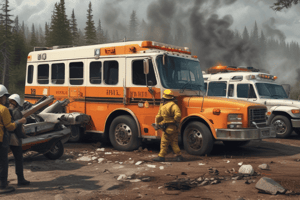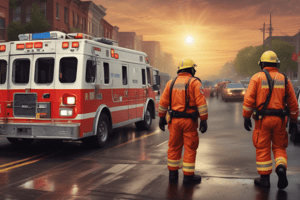Podcast
Questions and Answers
What role does forensic medicine play in mass disasters?
What role does forensic medicine play in mass disasters?
Forensic medicine is vital for identifying victims, determining the cause and manner of death, and documenting findings.
What challenges arise in maintaining a chain of custody during mass casualty events?
What challenges arise in maintaining a chain of custody during mass casualty events?
The challenges include the rapid increase in the number of bodies, requiring substantial resources, and ensuring legal accountability for evidence.
List three methods used for identifying victims in mass disasters.
List three methods used for identifying victims in mass disasters.
Dental records, fingerprints, and DNA are three common methods used for victim identification.
Why is it important to preserve remains in mass disaster situations?
Why is it important to preserve remains in mass disaster situations?
What is the function of a central coordinating body in victim identification processes?
What is the function of a central coordinating body in victim identification processes?
What are the critical factors for forensic investigations at incident scenes?
What are the critical factors for forensic investigations at incident scenes?
How do medical records contribute to victim identification in mass disasters?
How do medical records contribute to victim identification in mass disasters?
What specialized teams are needed for identification in mass disaster scenarios?
What specialized teams are needed for identification in mass disaster scenarios?
What role do imaging techniques play in postmortem examinations during mass disasters?
What role do imaging techniques play in postmortem examinations during mass disasters?
Explain the importance of documenting injuries and cause of death during an autopsy.
Explain the importance of documenting injuries and cause of death during an autopsy.
What are the ethical considerations that must be taken into account when dealing with deceased individuals during a mass disaster?
What are the ethical considerations that must be taken into account when dealing with deceased individuals during a mass disaster?
How can preservation of tissues and organs benefit future investigations in mass disaster scenarios?
How can preservation of tissues and organs benefit future investigations in mass disaster scenarios?
What steps should be taken to support families of victims in the aftermath of a mass disaster?
What steps should be taken to support families of victims in the aftermath of a mass disaster?
Describe the significance of disaster preparedness and training for forensic personnel.
Describe the significance of disaster preparedness and training for forensic personnel.
Why is transparency with the public important during disaster recovery phases?
Why is transparency with the public important during disaster recovery phases?
What factors should be considered when establishing protocols for managing deceased bodies after a disaster?
What factors should be considered when establishing protocols for managing deceased bodies after a disaster?
Flashcards
What are mass disasters?
What are mass disasters?
Large-scale events causing significant damage and affecting many people, requiring extensive resources for response and management.
What are some types of mass disasters?
What are some types of mass disasters?
Natural disasters, technological disasters, and conflicts/violence.
What role does forensic medicine play in mass disasters?
What role does forensic medicine play in mass disasters?
A branch of medicine that focuses on identifying victims, determining the cause of death, and documenting findings in mass fatality situations.
What is a major challenge in handling bodies in mass disasters?
What is a major challenge in handling bodies in mass disasters?
Signup and view all the flashcards
What is victim identification in mass disasters?
What is victim identification in mass disasters?
Signup and view all the flashcards
How is victim identification conducted in mass disasters?
How is victim identification conducted in mass disasters?
Signup and view all the flashcards
How are forensic investigations conducted in mass disaster scenes?
How are forensic investigations conducted in mass disaster scenes?
Signup and view all the flashcards
Why is preserving evidence important in mass disasters?
Why is preserving evidence important in mass disasters?
Signup and view all the flashcards
Autopsy
Autopsy
Signup and view all the flashcards
Disaster Autopsy
Disaster Autopsy
Signup and view all the flashcards
Cataloging Injuries
Cataloging Injuries
Signup and view all the flashcards
Imaging Techniques in Disaster Response
Imaging Techniques in Disaster Response
Signup and view all the flashcards
Victim Assistance in Mass Disasters
Victim Assistance in Mass Disasters
Signup and view all the flashcards
Disaster Response Protocols
Disaster Response Protocols
Signup and view all the flashcards
Simulations for Disaster Preparedness
Simulations for Disaster Preparedness
Signup and view all the flashcards
Ethical Considerations during Disaster Response
Ethical Considerations during Disaster Response
Signup and view all the flashcards
Study Notes
Introduction to Mass Disaster
- Mass disasters are catastrophic events affecting a large number of people simultaneously, often requiring extensive resources and specialized expertise for response and management.
- Types of mass disasters include natural disasters (earthquakes, floods, tsunamis, wildfires), technological disasters (industrial accidents, transportation accidents, pandemics), and conflicts/violence (wars, terrorist attacks).
- These events create significant challenges in identifying, processing, and providing services for the multitude of victims.
Forensic Medicine Considerations in Mass Disasters
- Forensic medicine plays a vital role in mass fatality situations by providing crucial services in identifying victims, determining cause and manner of death, and documenting findings.
- The scale of a mass disaster necessitates the rapid and systematic collection, recording, and preservation of evidence from all victims to ensure accurate investigations and support for grieving families.
Challenges Associated With Mass Casualty Events
- Rapid increase in volume of bodies to be handled – demanding substantial resources and increased manpower.
- Maintaining rigorous chain of custody for evidence for legal and investigative purposes.
- Preservation of remains, critical for accurate identification, and crucial for legal and family-oriented considerations.
- Determining the cause and manner of death, especially with decomposition, or when multiple individuals have similar circumstances of death.
Victim Identification Procedures
- Establishing a central coordinating body for the entire identification process and forensic pathology.
- Utilizing methods like dental records, fingerprints, and DNA in identification to establish individuality.
- Medical records and personal belongings can provide critical clues.
- Coordinating with various agencies/organizations for access to individual records for confirmation.
- Utilizing specialized teams well-versed in mass disaster identification protocols and techniques.
- Creating a secure environment to maintain forensic integrity.
Forensic Investigations in Incident Scenes
- Establishing the scene safely, prioritizing safety for forensic investigators.
- Collecting evidence, properly documenting all steps for legal accountability.
- Protecting and preserving the integrity of evidence; critical for investigation and legal proceedings.
- Addressing the possibility of diverse types of injuries and potentially the presence of weapons.
- Understanding and cataloging injuries specific to each individual.
Postmortem Examinations
- Autopsy procedures are adjusted for rapid processing of multiple bodies.
- Careful documentation of injuries and cause of death, including the detailed procedure and evidence used.
- Imaging techniques (e.g., X-rays, CT scans) play an essential role in identifying injuries and contributing to identifying victims.
- Preservation of tissues and organs for future analysis to determine the cause of death, or for other relevant purposes (e.g., toxicology).
Victim Assistance During Mass Disasters
- Timely identification of deceased is vital, enabling families access to their loss.
- Providing support for the families of casualties, offering psychological assistance, and access to grief counseling.
- Establishing procedures for informing families about the death of loved ones and their condition. Maintaining appropriate ethical standards for communication throughout the process.
Ethical Considerations in Mass Disaster Response
- Prioritizing the welfare of all individuals involved.
- Maintaining respectful handling of deceased bodies and remains.
- Ensuring accurate identification of victims and delivering accurate information to family members.
- Maintaining transparency with the public during the crisis and the recovery phase.
- Respecting cultural sensitivities.
Disaster Preparedness and Training
- Establishing disaster response plans to outline appropriate protocols and personnel needs.
- Establishing a robust system for training and education for forensic pathologists, investigators, and other related personnel involved in mass disasters with protocols and procedures specific to mass disasters.
- Implementing guidelines and regulations for managing dead bodies based on national and international standards.
- Simulating mass fatality incidents to prepare forensic and healthcare teams and evaluate their preparedness, procedures, and responses for effective implementation during real mass disasters.
Studying That Suits You
Use AI to generate personalized quizzes and flashcards to suit your learning preferences.





